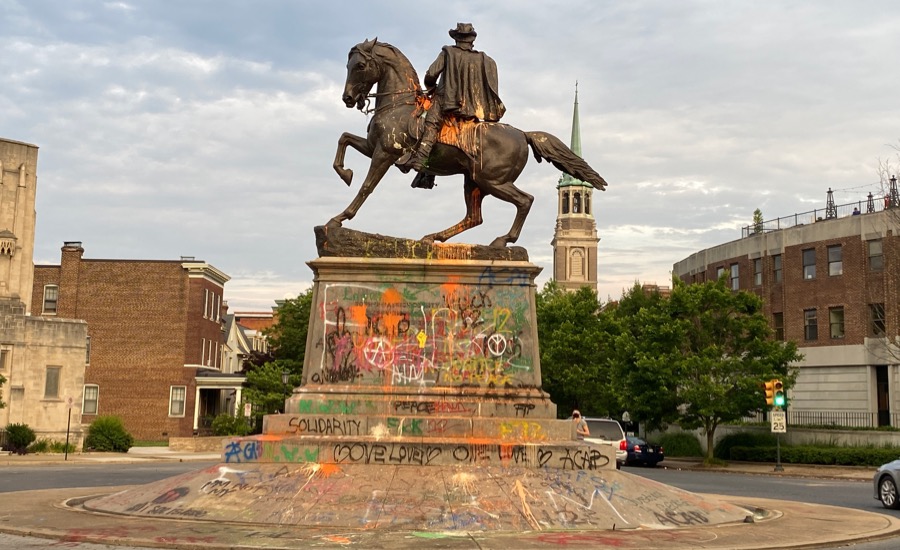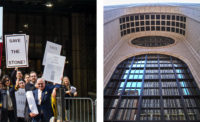Protests Take Aim at Confederate Monuments

J. E. B. Stuart Monument in Richmond, Virginia. Photo © Bryan Clark Green
On the evening of Sunday, May 31, Egyptologist Sarah Parcak was at home in her living room, tweeting tips on how to safely pull down an obelisk.
“The key,” she wrote, “is letting gravity work 4 you. Chances are good the obelisk extends into the ground a bit, so you want to get CHAINS NOT ROPE....”
But rope was all that protesters had on hand in downtown Birmingham, Alabama—along with several yards of tie-down strap, secured at one end to the tow hitch of a red GMC pickup. They had wrapped the other end around a sandstone column called “The Confederate Soldiers and Sailors Monument.”
The key to pulling one down is letting gravity work 4 you. Chances are good the obelisk extends into the ground a bit, so you want to get CHAINS NOT ROPE (it's 2020 AD not BC let metal work for you) extended tightly around the top (below pointy bit) and 1/3 down forming circles
— Sarah Parcak (@indyfromspace) June 1, 2020
After a peaceful march through the Civil Rights district, hundreds of men, women, and children had crowded into Linn Park, between Birmingham City Hall and the Jefferson County courthouse, encircling the 52-foot monument, the base of which featured engravings of an anchor, crossed sabers and a musket, plus a quote from Jefferson Davis, the former president of the Confederate States: "The manner of their death, was the crowning glory of their lives."

If any of the protesters read Parcak’s 15-tweet thread, they didn’t try her methods. The truck engine revved and squealed but the monument didn’t budge. Undaunted, they attacked with a few sledgehammers and power tools, but still made little progress. By 10:30 p.m., the Birmingham Police Department had cleared the park. The next day was Jefferson Davis’ birthday—a state holiday in Alabama. Birmingham Mayor Randall Woodfin had the monument removed, finishing what the protestors had started.
Since the May 25 police killing of George Floyd in Minneapolis, more than 30 Confederate monuments, memorials, and markers have come down nationwide. Statues have been toppled, smashed, and set ablaze during demonstrations in Washington, D.C., and at least 10 states, from Texas to Maryland. In Richmond, Virginia, protestors have converted a 60-foot statue of Robert E. Lee into a mixed-media installation that changes by the hour. With spray paint and digital projections, they have covered the granite pedestal with portraits of George Floyd and Frederick Douglass, and tags that say “I Can’t Breathe” and “Defund the Police.” The bronze general stands 14 feet tall atop his horse; one night in June, “BLM” was emblazoned across the animal’s flank.

“The Lee monument has become the focus of the protests in Richmond,” says Bryan Clark Green, chair of the Society of Architectural Historians’ (SAH) Heritage Conservation Committee. After years of measured responses, the SAH is one of two national architecture and design organizations that recently called for Confederate monuments to be eliminated from public spaces. On June 19, for the first time in the organization’s 80-year history, its leadership advocated for direct removal of artifacts: “The SAH supports and encourages the removal of Confederate monuments from public spaces.”
The previous day, the National Trust for Historic Preservation had avowed a renewed commitment to racial justice, citing a foundational obligation to help build “a more perfect union.”
“We believe it is past time for us, as a nation, to acknowledge that these symbols do not reflect, and are in fact abhorrent to, our values,” read part of the organization’s statement.

According to Paul Edmondson, president and CEO of the National Trust, the group has worked at the intersection of historic preservation and racial justice before this summer of protests. The Trust issued a statement decrying racist violence following the 2015 mass shooting at the Emanuel A.M.E. Church in Charleston, South Carolina, and the deadly 2017 attack on demonstrators in Charlottesville, Virginia, who were counter-protesting a neo-Nazi, white supremacist rally. But communities demanding the removal of Confederate monuments—in Dallas; Little Rock, Arkansas; Louisville, Kentucky; and elsewhere—spurred National Trust leadership to say something more forceful.
“After the murder of George Floyd, Ahmaud Arbery and others, we paused to look at our policies, practices, and positions,” Edmondson tells RECORD, “particularly to examine the aspects of embedded racism in our own institutions.”
One core aspect of the Trust’s mission is “to tell the full American story.” That meant putting “Black Lives Matter” and “Black History Matters” on National Trust letterhead, and acknowledging how many of the contentious monuments were erected to advance white supremacy and honor the Lost Cause mythology that romanticized a “Southern way of life” dependent on slavery.
“There’s a need to right a wrong,” Edmondson says. “The narrative that’s stated by these monuments is a very white narrative.”

The Birmingham monument stood as a stark example of white narrative for 115 years. A gift to the city and state from a local chapter of the United Daughters of the Confederacy (DOC), the cornerstone was laid in 1894 during a reunion of Confederate veterans in Birmingham; the completed monument was dedicated April 26, 1905—Confederate Memorial Day. A member of the monument committee urged the crowd to behold “the strength of that shaft… our work in commemoration of the deeds of valor to the entire Confederacy.”
Most Confederate memorials like this one were installed decades after the South’s defeat in the Civil War. “So many monuments like these, especially those erected between the 1890s and the 1920s were erected in public spaces to send a message,” says Green, of the SAH. “They were erected with the mission of controlling Black bodies in those spaces.”
In Birmingham, Richmond, and other cities with Confederate monument controversies, opponents of removal have urged recontextualization. Citizens have served on innumerable committees, panels, and task forces, most of which arrived at the same non-conclusion: Maybe interpretative signage or additional sculpture would diffuse the offense of these relics?

“None of the recontextualization ever happened,” Green says. “It didn’t happen anywhere.”
Preservation without context effectively sanctions ideals of white supremacy, says Green. But even with context, these monuments are painful and insulting to Black Americans, rendering “public” spaces into “white” spaces.
In a recent Washington Post op-ed, historian Keisha N. Blain observed that such markers were always meant to celebrate a racist past. “These symbols serve one primary purpose—to honor figures of the past who upheld an undemocratic vision of America,” Blain wrote. “They were created by white supremacists. And they function as a balm for white supremacists who long to return to a period when Americans regarded Black people as property.”
But the statements from SAH and the National Trust send an unequivocal message of changed sensibility—preservation cannot be used as a cover.
“As preservationists, we have never been about saving everything in amber,” Edmondson says. “If we did that, there’d be no room for the modern world.” He dismisses any suggestion that removing the Confederate statues from public property is erasing history.
“Our work is managing social change in a way that respects history,” Edmondson says. “History is not going to go away.”



